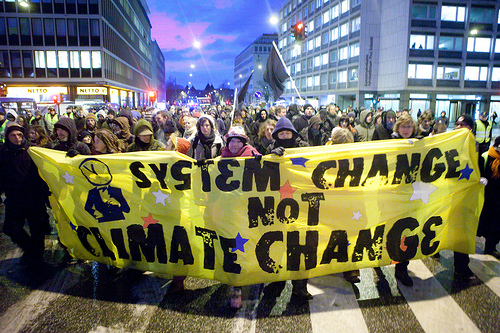 Traditionally, relationships between individuals and groups in a social movement are often organized through a dispersed manner at a grassroots level, which allows them to work in a more democratic fashion. Precisely because of those social movements retaining the notion of uniformity, self-management and self-determination, their organizational structure has been seen as a consistent model for participatory and sustainable society.
Traditionally, relationships between individuals and groups in a social movement are often organized through a dispersed manner at a grassroots level, which allows them to work in a more democratic fashion. Precisely because of those social movements retaining the notion of uniformity, self-management and self-determination, their organizational structure has been seen as a consistent model for participatory and sustainable society.
By activating and manifesting grassroots democracy, the social movements incite more and more people to get involved. In that sense, conventionally social movements are understood as representative of systems, which organize themselves by engaging in direct democratic practices in their structure and interaction with various actors. Thus, the nature of their organization facilitates an unpretentious anticipation for democratization of society and inauguration form of a global democracy. This general notion of social movements as self-organizing systems, however, needs to be complemented by understanding what social systems in general consists of, if the ultimate aim is to evaluate the state of contemporary social movements.
Over the last decades, a motivating and widely accepted conception within the literature of globalization studies is that all social systems including social movements are principally a set of centralized and decentralized networks that interrelates groups of people. In this regard, when we think about a social movement, we should not envisage a single group; rather, we must conceptualize a social movement as a network of plural nodes connected to each other through unremitting interaction. There is not an identical structure of networks, as either a social movement conducted in a pluralistic manner under a decentralized structure, or governed by predominant actors. The decentralization of social movements is frequently associated with dissemination of resources, power, activists, and so on. Additionally, not only the organizing system of social movements, but also the systems of modern society are defined by recognizing the importance of complex networks. As Manuel Castells (2000) has argued: “Modern society is a network society and it is part of a broad social structure”.
What Castells has predestined here by “network society” is, I think, related to today`s inclination to Post-Fordism in which society has organized around globalized and decentralized networks of capital, production and information. By linking this notion to understanding of contemporary social movements, I contend that present-day movements are Post-Fordist since they do not oppose traditional notions of domination. To be more precise, conceptualization of social systems and society in terms of complex networks has simultaneously shifted the conventional view of ascendancy from a unified authoritarian entity to networked forms of domination. This shift has profoundly affected the organization of social movements in a similar fashion of those global decentralized domination figures, so that they are enabled to correspond with today`s dictatorial regimes.
The vision that I have just proposed, in fact, has been somewhat presented in the extent literature of New Social Movements (NSMs), in which the emphasis is given to the origins of NSMs by initiating their ambitiousness to strive for democracy and justice as well as their use of decentralized networks in globalization process. A Post-Fordist nature of contemporary social movements attributes them an outlook which differentiates greatly from traditional social movements. In other words, when contemporary social movements respond to leading or dominant structures of society, unlike their past counterparts, they do not only use global communication channels but also the advanced tools of social media. In that sense, the established place of social movements today is not limited to streets as they quite often takes more virtual forms such as cyber activism.
The wave of social movements occurring in North Africa and Middle East offers prominent examples of how the seeds of contemporary movements opposing domination are firstly grounded in a virtual space for congregation through various social media tools such as Facebook, Twitter, YouTube, blogs, etc. The words of Wael Ghonim (2012), an Egyptian online activist and administrator of the Facebook page “Kullena Khaled Said” that has provided a conflagration for the 2011-revolution in Egypt, illustrates the importance of cyber activism: “The strategy for the Facebook page was to get public support for the cause…get people to participate in the page`s online campaigns and consequently make them decide to take the activism to the streets…I believe that if we want a free society, we just need to give people Internet access.”
At this point, I would like to emphasize that activists involved in contemporary social movements are often motivated by an idea that their actions might bring about more globally integrative and participatory democracy. Today`s social movements, and anti-globalization movements in particularly, encourage globalization which is organized from below rather than inflexible forms of globalization that are constructed top-down.
The social movements fabricated by networks show decentralized types of demonstration. In this regard, new social movements compared to old ones involves more transnationally distributed networks of information, capital, resources, communication, advanced social media and domination, which give them a cyber platform of activity rather than restrict the space of protest to the streets.
Text: Ayse Alkilic


